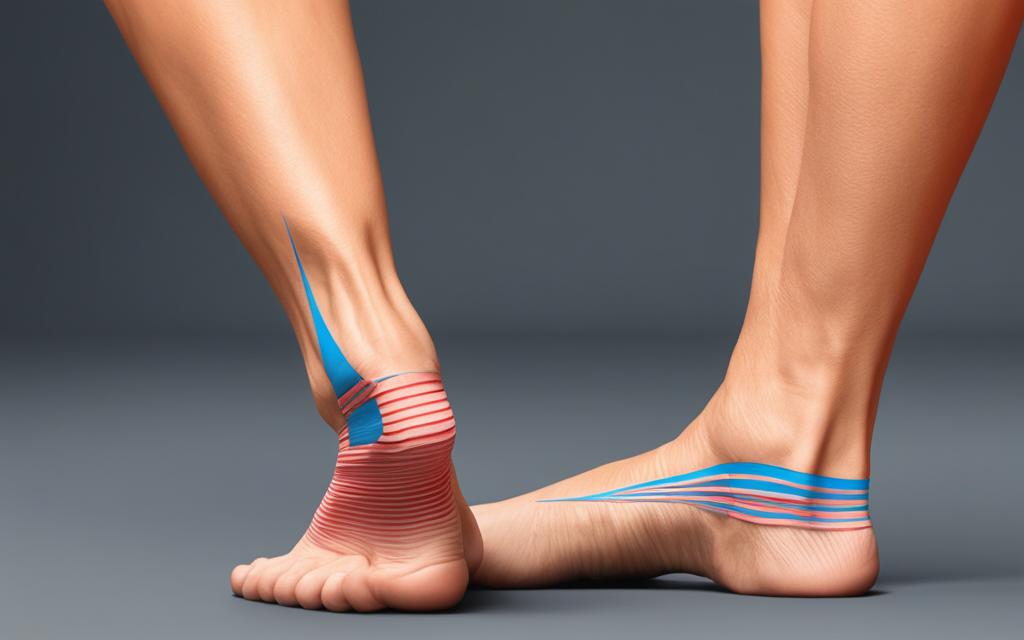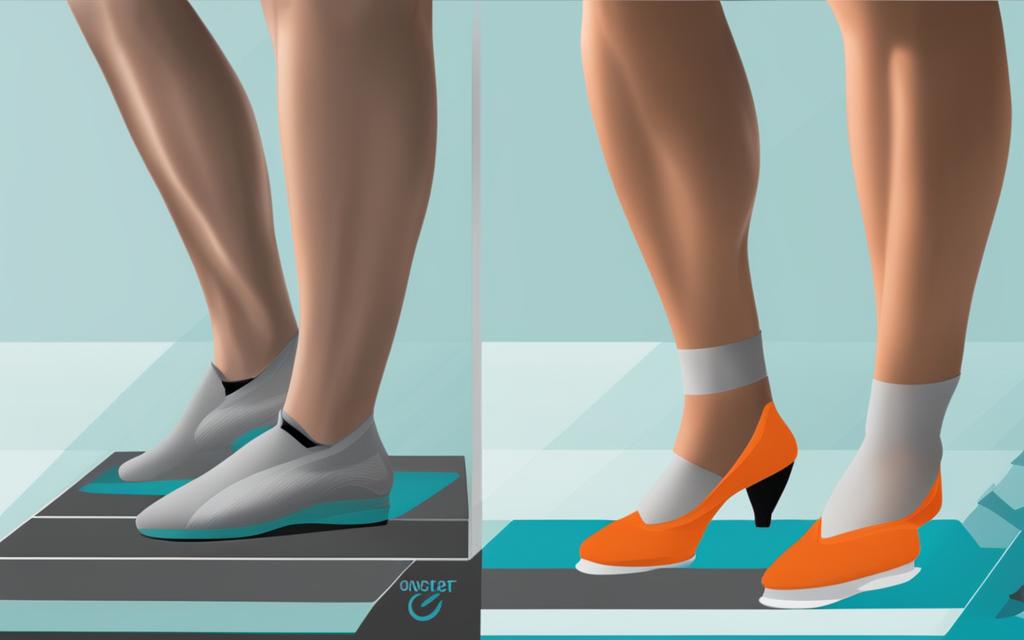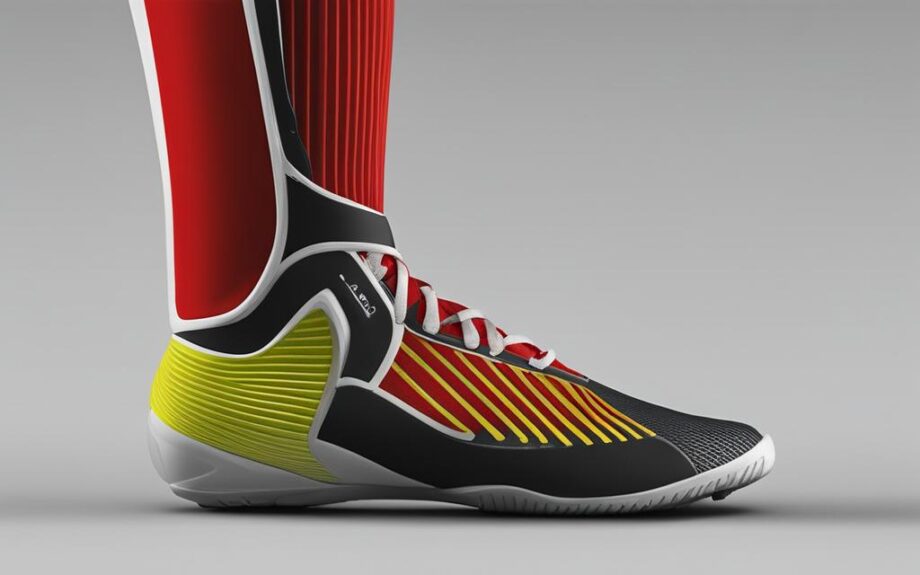Foot arch types play a crucial role in determining the overall structure and health of our feet. There are two primary foot arch types, and these are flat foot and high arch. Understanding the distinction between flat foot and high arch is crucial, as it can help individuals determine how best to care for their feet.
Flat feet are characterized by a low or no arch, which can cause the soles of the feet to come into full contact with the ground. High arches, on the other hand, have a pronounced arch and result in minimal contact between the sole and ground.
There are several implications of having flat feet or high arches on foot health, including postural alignment, balance, and susceptibility to injuries. For instance, individuals with flat feet may experience arch pain, shin splints, or stiffness in the feet, while those with high arches may be more susceptible to ankle sprains or strain on the balls of their feet.
Key Takeaways
- A foot arch plays a crucial role in determining the overall health of one’s feet and body.
- Flat foot and high arch are the two primary foot arch types.
- Flat feet have a low or no arch, and high arches have a pronounced arch.
- Both flat foot and high arch have implications on foot health and require appropriate management.
- Individuals with flat feet may experience arch pain, shin splints, and stiffness in the feet, while those with high arches may be more susceptible to ankle sprains and strain on the balls of their feet.
Understanding Flat Foot
Flat foot, also known as fallen arches, is a common condition in which the arch of the foot partially or completely touches the ground when standing. This condition affects approximately 20-30% of the population. The main causes of flat feet include genetics, weak arch muscles, injury or illness, and obesity.
There are several common symptoms of flat foot, including pain in the feet, ankles, and lower legs, especially after physical activity. Flat foot can also lead to weaker muscles in the feet and legs, causing instability and balance issues.
If left untreated, flat foot can lead to complications such as plantar fasciitis, tendonitis, and flatfoot deformity. However, there are exercises and techniques that can help manage and alleviate discomfort associated with flat feet. These include:
- Stretching exercises: Stretching the calf muscles, Achilles tendon, and plantar fascia can improve flexibility and alleviate discomfort.
- Arch strengthening exercises: Strengthening exercises such as heel raises and toe curls can improve the arch muscles and provide better support for the feet.
- Wearing supportive shoes: Wearing shoes with good arch support and cushioning can help reduce discomfort and provide better support for the feet.
It is important to consult with a medical professional for proper diagnosis and evaluation of flat foot. They can provide guidance on appropriate exercises and treatment options based on individual needs and severity of the condition.
“Flat feet are not always a problem, but when they are, it’s important to address them to avoid potential complications.”
Exploring High Arch
High arch, also known as pes cavus, is a condition that affects the shape of the foot. Unlike flat feet, where the arch collapses, individuals with high arches have a more pronounced arch that does not flatten when weight is applied to the foot. Some of the common causes of high arches include congenital conditions, neurological disorders, and foot injuries.
One of the primary symptoms of high arch is pain, particularly while standing or walking. People with high arches also tend to have a shorter foot length and may have difficulty finding properly fitting shoes. In severe cases, high arches can lead to calluses, corns, and ankle instability.
Treatment for high arch depends on the severity of the condition and the underlying cause. In some cases, orthotic devices, such as arch supports, may be prescribed to help distribute weight more evenly across the foot. Stretching and strengthening exercises can also help alleviate pain and prevent further complications.

If left untreated, high arches can lead to chronic foot pain and increase the risk of developing foot and ankle injuries. Therefore, it is important to seek medical attention if you are experiencing symptoms associated with high arches. By working with a healthcare professional, you can develop a comprehensive treatment plan that suits your specific needs and lifestyle.
Comparing Flat Foot and High Arch
While both flat foot and high arch are common foot arch types, they have unique characteristics that distinguish them from each other. In this section, we will compare and contrast the distinct biomechanical differences between the two foot arch types and their impact on posture, balance, and overall foot function.

The Flat Foot
Individuals with flat foot have little to no arch in their feet, which causes the entire foot to make contact with the ground when standing or walking. This can lead to an overpronation, where the feet roll too far inward, potentially causing strain on the ankles, knees, hips, and lower back. Individuals with flat foot may experience common symptoms such as pain, swelling, and fatigue in their feet and legs.
The High Arch
In contrast, high arches occur when the arch of the foot is significantly raised. This can lead to an underpronation, where the feet roll too far outward, potentially causing instability and strain on the ankle joint and heel. Individuals with high arches may experience common symptoms such as pain in the balls of the feet, metatarsalgia, and plantar fasciitis.
| Flat Foot | High Arch | |
|---|---|---|
| Appearance | The entire foot makes contact with the ground; little to no arch | A significantly raised arch; only the heel and ball of the foot make contact with the ground |
| Foot Function | Overpronation; feet roll too far inward | Underpronation; feet roll too far outward |
| Potential Complications | Strain on ankles, knees, hips, and lower back | Instability and strain on the ankle joint and heel |
Overall, individuals with either a flat foot or high arch should be aware of their unique characteristics and potential complications, and take measures to manage symptoms and maintain good foot health. In the next section, we will explore some tips, exercises, and treatment options to manage both flat foot and high arch.
Managing Flat Foot and High Arch
Managing flat foot and high arch is crucial in preventing associated symptoms and maintaining overall foot health. Here are some tips, exercises, and lifestyle modifications that individuals can incorporate into their daily routine:
Flat Foot Exercises
Regular exercises can help strengthen the muscles in the feet and alleviate discomfort associated with flat foot. Consider incorporating these exercises into your daily routine:
- Toe curls: Sit down and place a towel on the floor beneath your feet. Use your toes to scrunch up the towel and gradually pull it closer to you.
- Ankle rolls: Sit with your feet flat on the ground and gently roll your ankles clockwise and counterclockwise.
- Calf stretches: Stand facing a wall and stretch your calf muscles by placing one foot forward and one foot back. Keep your back leg straight while bending your front knee.
Practicing these exercises regularly can help reduce pain and discomfort associated with flat foot.
High Arch Treatment
The following treatment options can help alleviate symptoms related to high arch:
- Arch supports: Wearing arch supports can help provide additional support and cushioning to the feet, reducing discomfort associated with high arch.
- Ice massage: Massaging the affected area with ice can help alleviate pain and reduce inflammation.
- Proper footwear: Wearing shoes with adequate cushioning and support can help reduce the impact of high arch on the feet and body.
Combined with exercises, these treatment options can help manage and alleviate symptoms related to high arch.
| Tip | Description |
|---|---|
| Stay active | Regular exercise can help strengthen foot muscles and reduce discomfort |
| Wear proper footwear | Ensure shoes fit well and provide adequate support and cushioning |
| Consider orthotics | Orthotic inserts can provide additional support and cushioning to the feet, |
| Ice massage | Massaging the affected area with ice can help alleviate pain and inflammation |
Note: If you experience persistent pain or discomfort in the feet, it is recommended you seek advice from a medical professional.

Conclusion
In summary, understanding the differences between flat foot and high arch is crucial for maintaining good foot health. While flat foot is characterized by a lack of arch, high arch involves an excess of arch in the foot. Both foot arch types can lead to discomfort, pain, and potential complications if left untreated.
By incorporating exercises, lifestyle modifications, and seeking appropriate treatment, individuals can effectively manage the symptoms associated with flat foot and high arch. Regular check-ins with a healthcare professional or podiatrist can also help identify any issues early on and prevent long-term complications.
So, whether you have flat foot, high arch, or are unsure about your foot type, taking a proactive approach to foot health is always advisable. By doing so, you can enjoy improved balance, posture, and overall foot function.
Thank you for reading our article on flat foot vs high arch. We hope it has provided valuable insights and information to help you better understand and manage your foot health.
FAQ
What is the difference between flat foot and high arch?
Flat foot is characterized by a low or no arch, causing the entire sole of the foot to make contact with the ground. On the other hand, a high arch refers to a pronounced arch on the sole of the foot.
What are the symptoms of flat feet?
Common symptoms of flat feet include foot pain, swelling, difficulty standing on tiptoes, and an inward rolling of the ankle.
What are the symptoms of high arches?
Symptoms of high arches may include foot pain, instability, difficulty finding comfortable shoes, and a tendency for the feet to roll outward.
What causes flat feet?
Flat feet can be caused by a variety of factors, such as genetic predisposition, weak arch muscles, obesity, injury, or certain medical conditions like arthritis or diabetes.
What causes high arches?
High arches can be caused by neurological conditions, such as cerebral palsy, muscular dystrophy, or inherited structural abnormalities. In some cases, high arches may also be related to certain foot injuries or arthritis.
Are there any exercises that can help with flat feet?
Yes, certain exercises can help strengthen the muscles that support the arch and alleviate discomfort associated with flat feet. These exercises may include toe curls, arch lifts, and calf stretches.
How can high arches be treated?
Treatment for high arches aims to relieve any pain or discomfort and address any complications that may arise. This can involve wearing supportive footwear, using orthotic inserts, physical therapy to strengthen the foot and ankle, and in severe cases, surgery.
How do flat feet and high arches affect foot health?
Both flat feet and high arches can impact foot health and overall body alignment. Flat feet can lead to overpronation and increase the risk of developing conditions such as plantar fasciitis and shin splints. High arches can cause poor shock absorption, instability, and put more pressure on the outer edges of the feet.
